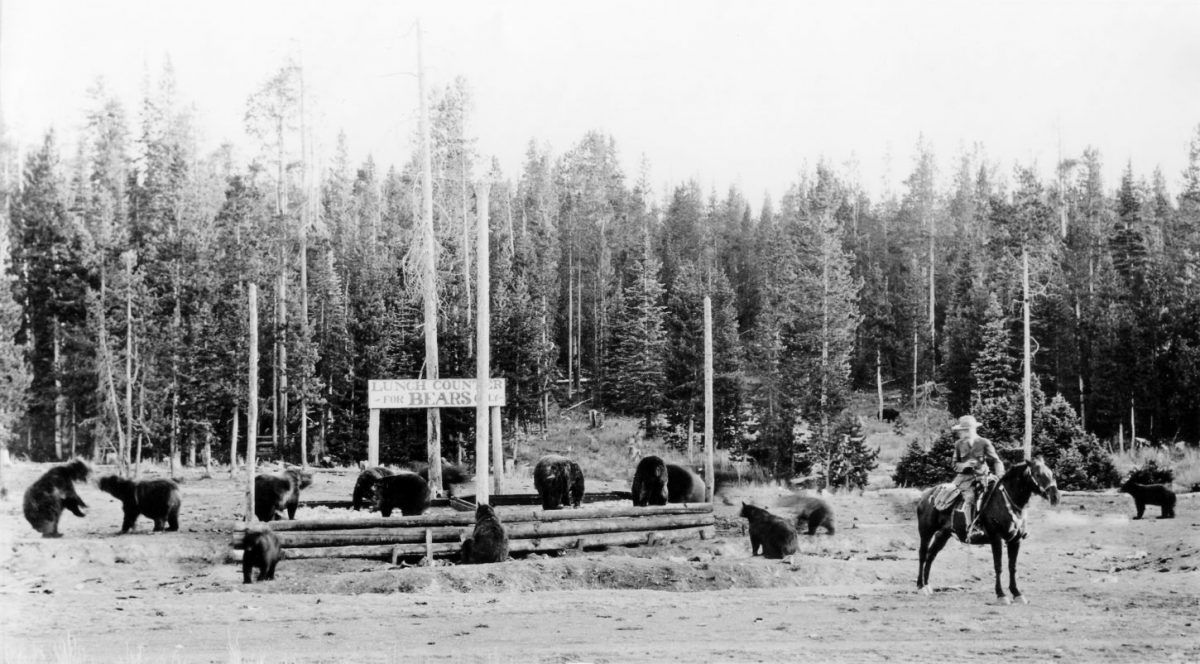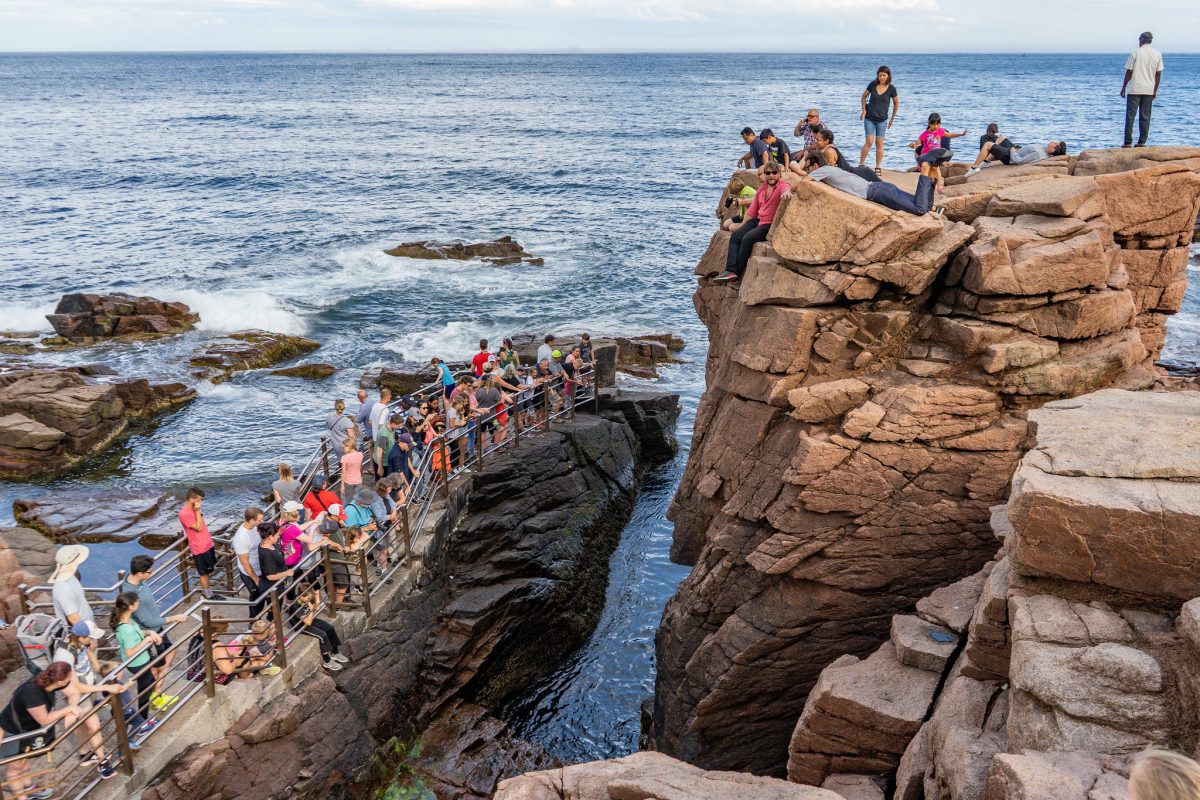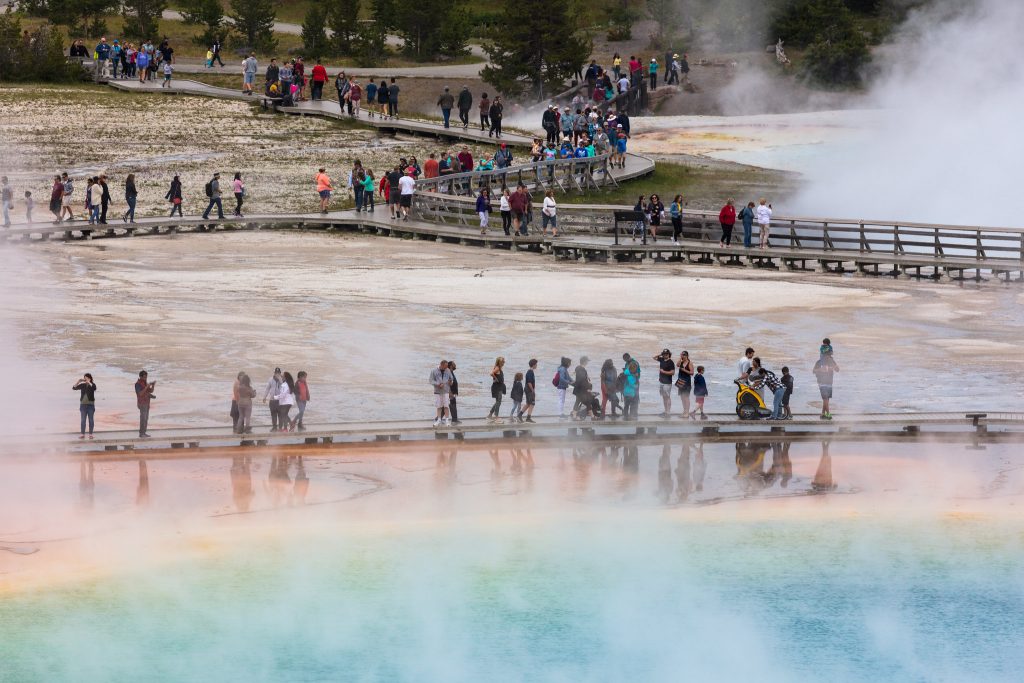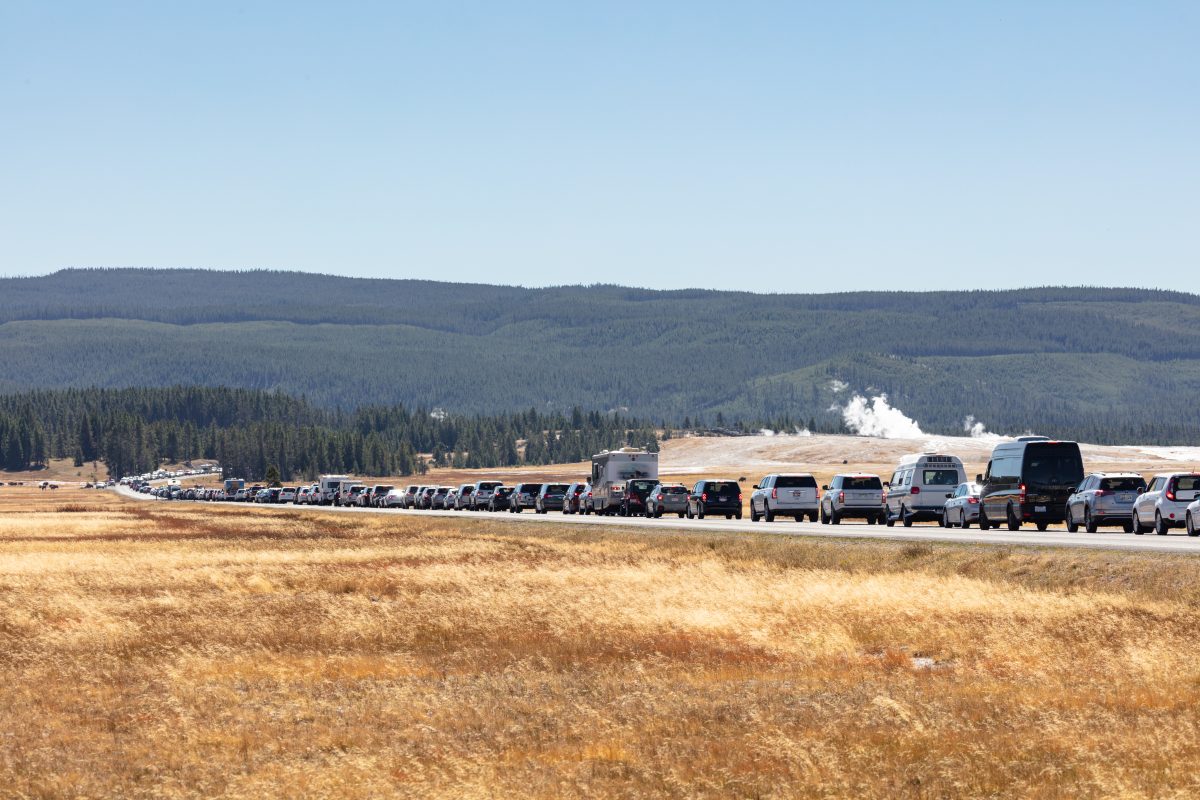This article was originally published on April 23, 2019.
When Congress established Yellowstone as the first national park in 1872 — sparking a national movement that ultimately led to the creation of the National Park Service (NPS) in 1916 and hundreds of subsequent national parks and historic sites — Yellowstone’s majesty was reduced to a circus.
Onlookers watched as bears ate from troughs under a sign reading “Lunch Counter for Bears,” and some visitors had the opportunity to hand-feed bears from a garbage cart. Those hoping to get a closer look at geysers and hot springs trampled their way across the landscape. Vandals and poachers also ran rampant, cutting down trees and killing any wild game they happened across.
But as the federal government soon discovered, protecting such land as “a public park or pleasuring-ground for the benefit and enjoyment of the people” also necessitated protections for the region’s natural resources if future generations were to enjoy these places as well.
Now, nearly 150 years later, NPS is charged with weighing visitor demand with ecosystem needs as the desire to recreate on these public lands has skyrocketed. “Our mission is to preserve national parks for their enjoyment today and for generations to come,” says Jeff Olson, chief of NPS’ Office of Science Communications. “That means we manage for preservation of the resource first and use the science of visitor use management to balance preservation with use. This makes sure that visitors have a world-class experience and that tomorrow’s visitors will have that same opportunity.”
 The opportunities afforded by these natural wonders, however, are both a blessing and a curse as parks have become overrun with tourists hoping to capture their experience in 1,200-by-800 pixels.
The opportunities afforded by these natural wonders, however, are both a blessing and a curse as parks have become overrun with tourists hoping to capture their experience in 1,200-by-800 pixels.
Between 2000 and 2019, park visitation — meaning visitors to all 419 of the nation’s national parks, monuments and historic sites — increased by approximately 41 million people for a total of more than 327.5 million visitors; this represents the third highest visitation record since record keeping began in 1904. In that year, just 120,690 people toured what were then the country’s five national parks.
Some blame social media sites like Instagram for the spike in national park visitation as travelers, lured by awe-inspiring photos, flock to these areas. Whatever the cause, national parks, along with their ecosystems, are paying the price for their splendor.
In many of the nation’s most popular parks — places like Great Smoky Mountains National Park, the Grand Canyon, Zion and Yosemite — congested roadways, parking lots and trails are just one indicator of the growing problems precipitated by skyrocketing attendance. Some sites see as many as tens of thousands of cars each day during peak seasons, The Guardian reports. One study even revealed in the parks levels of ozone — a major air pollutant — matching those of the nation’s largest cities.
According to Olson, “full parking areas often lead motorists to park illegally,” damaging natural resources. Overcrowding has also led to more vehicle accidents — some involving wildlife. The most recent NPS crash data available indicate that the national parks have a higher rate of crashes involving wildlife than all other public roadways nationally. From 1990 to 2005, wildlife-vehicle collisions were the No. 1 cause of single-vehicle crashes in the NPS system and accounted for 10 percent of all vehicle crashes.
“We want to see these lands well taken care of, we want to see wildlife flourish. At the same time, we want the recreation opportunity — and those two things are definitely coming into conflict in many areas.”
In Yellowstone alone, annual visitation has increased by more than 40 percent since 2008, “causing overflowing parking lots, a rise in traffic jams, roadside soil erosion and vegetation trampling, and unsanitary conditions around busy bathrooms,” according to the park’s website. This increase in attendance has also led to more people going off trail or creating what NPS calls “social trails” throughout the park; these are unwanted and unofficial trails created by visitors that damage natural resources.
As the parks become more crowded, NPS — already underfunded and in many cases understaffed — increasingly struggles to keep up. With approximately $12 billion in deferred maintenance in the parks, large crowds are taking their toll on an already crumbling infrastructure. In fiscal year 2017 alone, deferred maintenance increased by $275 million, or 2.5 percent, due to an increase in park attendance. (The Great American Outdoors Act, which was passed by the Senate in June 2020, would significantly reduce this backlog should it gain approval in the House.)
More visitors also means more people who are unprepared or unaware of the perils of nature. Search and rescue (SAR) teams were deployed for a total of 3,453 incidents in national parks in 2017 — costing NPS 84,000 man hours and more than $3 million, according to NPS data. In Yellowstone, SAR efforts increased 130 percent between 2014 and 2016.
Overcrowding poses its own issues. “Crowded trails can result in visitors going off a designated trail where consequences can include slips and falls on unstable terrain, encountering wildlife and poisonous plants and increased likelihood of getting lost and requiring rescue,” says Olson.
Coincidentally, the upsurge in visitors to national parks impacts the visitor experience. And while most all of us would like to see these wild places remain that, we also crave the experience they offer.
“We want to see these lands well taken care of, we want to see the diversity on the landscape, we want to see wildlife flourish. At the same time, we want the recreation opportunity — and those two things are definitely coming into conflict in many areas,” says Holly Fretwell, director of outreach and a research fellow at the Property and Environment Research Center (PERC), a free-market environmental think tank located in Bozeman, Mont.
Weighing Solutions
NPS has been working to gather information about best practices parks can use to “reduce crowding and congestion, while also providing better access to visitors,” says Olson.
One of the most immediate ways NPS can do this, he says, is by providing information as quickly as possible. “This includes real-time looks at the lines at entry stations, up-to-date signage in parks about parking lot space and by staffing areas that typically fill up with NPS employees who can guide direct traffic,” Olson says.

Other mechanisms being considered and implemented by some parks include advanced reservations, shuttle buses and timed-entry passes. Acadia National Park in Maine has proposed such a system in which visitors would have a specific window to enter the park but, once inside, could still spend as much time there. The proposal also includes plans to phase out right-lane parking along the main road, add additional parking spaces and construct a new parking lot.
Park officials at Arches National Park in Utah abandoned the idea of introducing a reservation system after research revealed that it could cost the region $11 million to $22 million in lost economic spending a year. Now being considered is a shuttle system — previously deemed impractical, according to National Parks Traveler — and a second entrance.
Zion National Park is also working on a crowd-management plan, and in Yellowstone, an additional 1-acre parking lot was created in 2017 to help reduce illegal parking on roadsides.
“I think, a lot of times, people are led to believe that the more people the better, but that’s not necessarily the case,” says Fretwell. “Some of our local economies in these regions are finding that they’re over-inundated and overcrowded themselves, which is causing problems.”
But where there is conflict, there is also opportunity. High numbers of visitors translates into more money to be made to help offset additional infrastructure and maintenance costs — should entrance fees be raised.
Most national park entrance fees range from $5 per person to $35 per carload, says Fretwell. “If you look at some of the crown jewels of the parks — Yellowstone, Yosemite, the Grand Canyon — it costs $35 for a carload of people to enter the park, and they have a seven-day pass to come and go from that park,” she notes. “That’s really a pittance when we think about what it actually costs to manage those parks, and it’s a pittance when we think about the amount of money that people are spending to get to most of those parks.”
According to Fretwell, if Yellowstone were to charge all visitors a daily $13 fee, based on 2014 data, “we would cover the entire operating budget of [that] park on an annual basis.”
“Fees have demonstrated to us to do a really good job of changing the behavior of individuals [with regard to] when they visit and what they do within those regions.”
Of course, there is always concern about pricing people out of the parks. But, as Fretwell points out, $13 is comparable to what you would pay for a movie ticket in most cities.
Congestion pricing is another approach Fretwell recommends, one that she says has seen some success in state parks. This is a strategy in which parks charge more during peak seasons and less during shoulder, or off, seasons to try to encourage people to visit during non-peak times of year. Charging non-residents more is also an option.
“If you go to a park in another country, oftentimes, as an international visitor, you pay a considerably higher price than citizens from that country,” says Fretwell. “Fees have demonstrated to us to do a really good job of changing the behavior of individuals [with regard to] when they visit and what they do within those regions.”
Picking Up the Tab
In 2018, after his proposal to implement surge-pricing — which would have nearly doubled entrance fees at 17 national parks during the peak season — failed to pass Congress, then Interior Secretary Ryan Zinke advocated instead for a $5 increase in most parks’ entrance fees to help address the backlog of deferred maintenance. Despite this increase, many of the most popular parks still struggle to address all their maintenance and infrastructure needs at a time of skyrocketing attendance, and for many, the 2018-2019 government shutdown only made matters worse.
Individually, some parks have chosen to up their fees to address such needs. Both Denali and Capitol Reef National Parks implemented increases in 2019. At Denali, it now costs $15 per person — instead of $10 — for a seven-day pass, which is expected to raise an additional $1 to $1.25 million each year. Capitol Reef’s seven-day entrance fee increased from $15 per vehicle to $20 and $7 per person to $10 that same year.
While PERC — which refers to itself as “the home of free market environmentalism” — looks to markets and property rights to improve environmental quality, the organization emphasizes the importance of collaboration between the free market and government.

“What we’ve found through that approach is that we come up with very cooperative answers where people are working together and negotiating,” says Fretwell, “rather than a system that seems to be much more acrimonious … where people are fighting against each other through a political system.”
When it comes to property rights, however, coming up with market solutions for every problem can be challenging. Fretwell cites as an example any effort to control vehicle pollution in national parks. “It’s difficult for us to make each individual responsible and liable for the pollution coming out of their vehicle, so it becomes a harder problem to solve with markets alone,” she says.
This is where park visitors have the opportunity to play a larger role. Becoming better stewards of our natural resources and majestic landscapes requires more of us than just staying on trail, leaving no trace and letting wildlife be. It means we must be more willing to pick up the conservation tab for these iconic places.
“We really need to think carefully about the legislation that’s being passed and how we respond as users to our parks — and as citizens. As recreationalists, we do not pay a whole lot, and we certainly don’t pay the full cost of our recreation on the landscape, let alone the conservation costs that exist just to protect those lands with or without visitors,” says Fretwell. “If we really want to see good conservation, we should be … paying to play a little bit more rather than relying on appropriations.”





